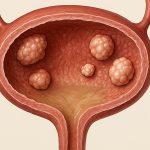Staghorn calculi – the very name evokes images of something imposing and potentially troublesome. And rightly so. These aren’t your typical kidney stones; they are large, branching formations that can significantly impact renal function and cause considerable discomfort. Understanding what these complex structures are, how they develop, and crucially, how they’re treated is vital for anyone concerned about kidney health or those experiencing related symptoms. Often discovered incidentally during imaging for other conditions, staghorn calculi present a unique challenge in urology due to their size and intricate shape.
Beyond the discomfort, untreated staghorn stones can lead to serious complications including recurrent urinary tract infections, chronic pain, and even kidney damage. Fortunately, advancements in medical technology and treatment strategies have greatly improved outcomes for patients facing this condition. This article aims to provide a comprehensive overview of staghorn calculi, delving into their formation, diagnostic methods, and the diverse range of treatment options available, empowering readers with knowledge about this often-intimidating aspect of kidney stone disease.
Understanding Staghorn Calculi: Formation and Characteristics
Staghorn calculi are among the most complex types of kidney stones a person can develop. Unlike smaller, more common kidney stones which often pass on their own, staghorn stones fill a significant portion – or even the entirety – of the renal pelvis, the funnel-shaped structure within the kidney that collects urine before it travels to the bladder. Their name derives from their resemblance to the antlers of a male deer, characterized by branching and irregular formations. The sheer size alone sets them apart; typically exceeding 2 centimeters in diameter, but often growing much larger.
The development of staghorn calculi is usually slow, taking months or even years. They aren’t generally caused by the same factors that lead to smaller kidney stones. Instead, they almost always form as a result of chronic urinary tract infections (UTIs) – specifically those involving urea-splitting bacteria like Proteus mirabilis. These bacteria break down urea in the urine, increasing its alkalinity and promoting the formation of struvite crystals (magnesium ammonium phosphate). Over time, these crystals accumulate and coalesce into large, branching stones. Less frequently, staghorn calculi can also develop due to obstructions within the urinary tract that hinder complete bladder emptying, leading to stagnant urine and stone formation.
It’s important to understand that risk factors for developing UTIs – such as female anatomy, catheter use, incomplete bladder emptying due to neurological conditions, or structural abnormalities of the urinary tract – indirectly increase the risk of staghorn calculi. While anyone can develop these stones, individuals with a history of recurrent UTIs are at significantly higher risk. Symptoms aren’t always immediately apparent; many patients remain asymptomatic for extended periods until the stone causes obstruction, pain, or frequent infections.
Diagnosis and Initial Assessment
Diagnosing staghorn calculi typically begins with recognizing potential symptoms, which can be vague initially. These may include flank pain (pain in the side of your back), recurring UTIs, blood in the urine (hematuria), nausea, and vomiting. However, many individuals remain asymptomatic for a considerable time, making early detection challenging. A physician will usually suspect kidney stones if these symptoms are present or if an incidental finding is made during imaging performed for other reasons.
The primary diagnostic tool for identifying staghorn calculi is imaging. Several modalities can be used:
- Computed Tomography (CT) scan without contrast: This is often the first-line imaging test, providing detailed images of the kidneys and urinary tract. It’s highly effective at detecting stones of all sizes and compositions.
- Intravenous Pyelogram (IVP): While less common now due to the availability of CT scans, IVP involves injecting a contrast dye into a vein and then taking X-rays to visualize the kidney and ureters. It can show obstructions caused by the stone.
- Ultrasound: Useful as an initial screening tool, particularly in pregnant patients or those avoiding radiation exposure. However, it may not always detect smaller stones accurately.
Once a staghorn calculus is identified, further assessment is crucial to determine its size, location, and impact on kidney function. This often includes blood tests to assess renal function (checking creatinine and glomerular filtration rate) and urine analysis to identify any ongoing infection or the presence of struvite crystals. A detailed understanding of these factors informs treatment planning.
Treatment Options: A Multifaceted Approach
Treating staghorn calculi is rarely straightforward due to their size and complexity. The goal isn’t simply to remove the stone; it’s also to address underlying issues like chronic infection and preserve as much kidney function as possible. Treatment strategies vary depending on individual patient factors, stone characteristics, and overall health. Percutaneous Nephrolithotomy (PCNL) is often considered the gold standard for removing large staghorn calculi.
-
Percutaneous Nephrolithotomy (PCNL): This minimally invasive surgical procedure involves making a small incision in your back to access the kidney directly. A nephroscope – a thin, telescope-like instrument – is inserted through the incision to visualize and break up the stone using laser or pneumatic energy. The fragments are then removed through the same tract. PCNL is highly effective for large and complex stones but carries risks such as bleeding, infection, and damage to surrounding organs. It’s generally preferred for stones larger than 2 centimeters.
-
Shock Wave Lithotripsy (SWL): While less effective for very large staghorn calculi, SWL can be used in conjunction with other treatments or for smaller fragments remaining after PCNL. This non-invasive technique uses shock waves to break up the stone into smaller pieces that can then pass through the urinary tract. However, it’s not suitable for all patients and may require multiple sessions.
-
Ureteroscopy: In some cases, a ureteroscope – a thin, flexible endoscope – can be inserted through the urethra and bladder to reach the kidney and remove stone fragments. This is typically used for smaller stones or after initial fragmentation with other techniques. Often combined with laser lithotripsy to break down remaining fragments.
Beyond stone removal itself, addressing underlying causes like chronic UTI is paramount. Long-term antibiotic therapy may be necessary to eradicate persistent infection and prevent recurrence. Surgical correction of any anatomical abnormalities contributing to urinary stasis can also play a vital role in preventing future stone formation. Patients often require ongoing monitoring after treatment to assess kidney function and detect any complications early on. The choice of treatment must always be individualized, taking into account the patient’s overall health status, stone characteristics, and preferences.
Preventing Recurrence: Long-Term Management
Successfully removing a staghorn calculus is only half the battle; preventing recurrence requires diligent long-term management. This involves addressing underlying risk factors and adopting lifestyle modifications to minimize stone formation. Hydration is critical; drinking plenty of fluids helps dilute urine and reduces the concentration of minerals that can form stones. Aim for at least 2–3 liters of water per day, unless your doctor advises otherwise due to other medical conditions.
Regular follow-up appointments with a urologist are essential. These appointments typically include periodic imaging (CT scans or ultrasounds) to monitor for stone recurrence and assess kidney function. Urine analysis can also help detect early signs of infection or crystal formation. Patients with a history of struvite stones should be vigilant about recognizing symptoms of UTI and seeking prompt treatment.
Dietary modifications may also play a role, although the impact on staghorn calculi is less well-defined than for other types of kidney stones. Reducing sodium intake can help lower calcium excretion in the urine. If you have underlying medical conditions that increase your risk of stone formation – such as hyperparathyroidism – addressing those conditions is crucial. Ultimately, a proactive and collaborative approach between patient and physician is key to minimizing the risk of recurrence and maintaining long-term kidney health.





















